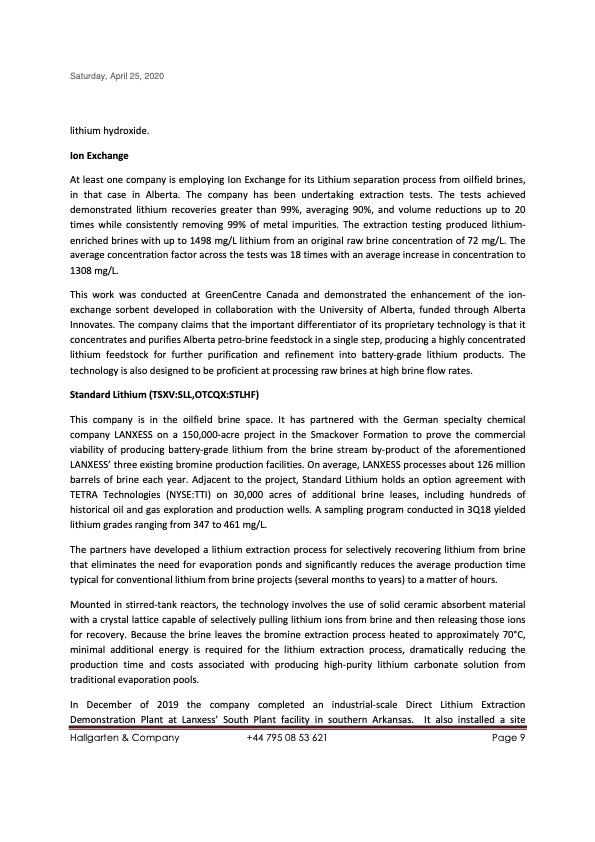
PDF Publication Title:
Text from PDF Page: 010
Saturday, April 25, 2020 lithium hydroxide. Ion Exchange At least one company is employing Ion Exchange for its Lithium separation process from oilfield brines, in that case in Alberta. The company has been undertaking extraction tests. The tests achieved demonstrated lithium recoveries greater than 99%, averaging 90%, and volume reductions up to 20 times while consistently removing 99% of metal impurities. The extraction testing produced lithium- enriched brines with up to 1498 mg/L lithium from an original raw brine concentration of 72 mg/L. The average concentration factor across the tests was 18 times with an average increase in concentration to 1308 mg/L. This work was conducted at GreenCentre Canada and demonstrated the enhancement of the ion- exchange sorbent developed in collaboration with the University of Alberta, funded through Alberta Innovates. The company claims that the important differentiator of its proprietary technology is that it concentrates and purifies Alberta petro-brine feedstock in a single step, producing a highly concentrated lithium feedstock for further purification and refinement into battery-grade lithium products. The technology is also designed to be proficient at processing raw brines at high brine flow rates. Standard Lithium (TSXV:SLL,OTCQX:STLHF) This company is in the oilfield brine space. It has partnered with the German specialty chemical company LANXESS on a 150,000-acre project in the Smackover Formation to prove the commercial viability of producing battery-grade lithium from the brine stream by-product of the aforementioned LANXESS’ three existing bromine production facilities. On average, LANXESS processes about 126 million barrels of brine each year. Adjacent to the project, Standard Lithium holds an option agreement with TETRA Technologies (NYSE:TTI) on 30,000 acres of additional brine leases, including hundreds of historical oil and gas exploration and production wells. A sampling program conducted in 3Q18 yielded lithium grades ranging from 347 to 461 mg/L. The partners have developed a lithium extraction process for selectively recovering lithium from brine that eliminates the need for evaporation ponds and significantly reduces the average production time typical for conventional lithium from brine projects (several months to years) to a matter of hours. Mounted in stirred-tank reactors, the technology involves the use of solid ceramic absorbent material with a crystal lattice capable of selectively pulling lithium ions from brine and then releasing those ions for recovery. Because the brine leaves the bromine extraction process heated to approximately 70°C, minimal additional energy is required for the lithium extraction process, dramatically reducing the production time and costs associated with producing high-purity lithium carbonate solution from traditional evaporation pools. In December of 2019 the company completed an industrial-scale Direct Lithium Extraction Demonstration Plant at Lanxess’ South Plant facility in southern Arkansas. It also installed a site Hallgarten & Company +44 795 08 53 621 Page 9PDF Image | Unconventional Lithium from Brine

PDF Search Title:
Unconventional Lithium from BrineOriginal File Name Searched:
UnconventionalLithium_April2020.pdfDIY PDF Search: Google It | Yahoo | Bing
Product and Development Focus for Infinity Turbine
ORC Waste Heat Turbine and ORC System Build Plans: All turbine plans are $10,000 each. This allows you to build a system and then consider licensing for production after you have completed and tested a unit.Redox Flow Battery Technology: With the advent of the new USA tax credits for producing and selling batteries ($35/kW) we are focussing on a simple flow battery using shipping containers as the modular electrolyte storage units with tax credits up to $140,000 per system. Our main focus is on the salt battery. This battery can be used for both thermal and electrical storage applications. We call it the Cogeneration Battery or Cogen Battery. One project is converting salt (brine) based water conditioners to simultaneously produce power. In addition, there are many opportunities to extract Lithium from brine (salt lakes, groundwater, and producer water).Salt water or brine are huge sources for lithium. Most of the worlds lithium is acquired from a brine source. It's even in seawater in a low concentration. Brine is also a byproduct of huge powerplants, which can now use that as an electrolyte and a huge flow battery (which allows storage at the source).We welcome any business and equipment inquiries, as well as licensing our turbines for manufacturing.| CONTACT TEL: 608-238-6001 Email: greg@infinityturbine.com | RSS | AMP |